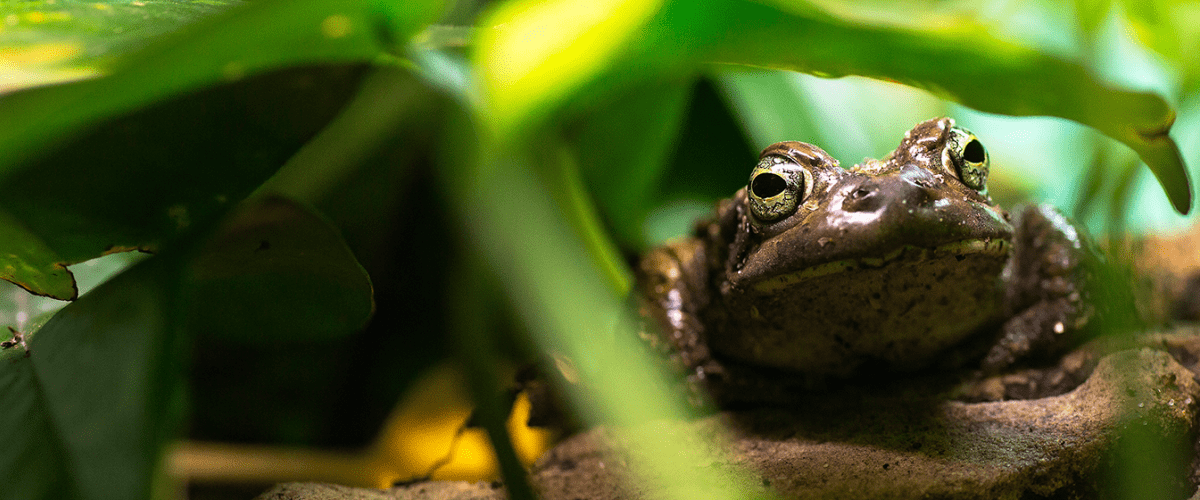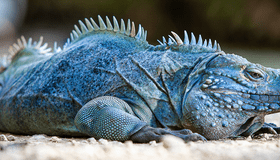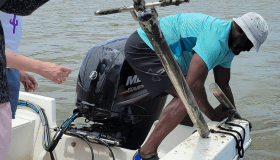
June 22, 2023 — Frogs, toads, salamanders, newts and lesser-known, worm-like caecilians are dying off around the world at an unprecedented rate. According to the U.S. Geological Survey, amphibian populations are declining at a rate of about 3.5% per year in the United States alone, with more severe declines in certain regions, including the West Coast and Rocky Mountain regions.
For more than 20 years, Morris Animal Foundation has funded amphibian health studies to help save amphibians in the United States and around the world through health and conservation research.
Much of our funding supports studies in three major health areas:
- Reproductive technologies (to support conservation programs)
- Infectious and emerging diseases
- Genomic conservation tools
What’s Happening to Amphibians?
The reasons for the amphibian declines are complex. Amphibians are extremely sensitive to changes in their habitats because their skin is an important organ of respiration. Even small amounts of pesticides, pollutants, ultraviolet radiation and temperature changes can have a big impact on amphibian health. For coastal amphibians, rising sea levels add another layer of complexity with increasing salinity, forever changing the water systems amphibians need to live and breed. Habitat destruction and poaching/illegal trade also are concerns.
Added to this mixture is another major threat – an emerging chytrid fungus that develops on their fragile skin, impairing their ability to breathe and absorb water (amphibians don’t drink water like we do!). This deadly fungus called Batrachochytrium dendrobatidis (Bd), and its cousin Batrachochytrium salamandrivorans (Bsal), are devastating amphibian populations around the world, and have contributed to the extinction of about 90 known species.
How We Are Helping (Thanks to You!)
Morris Animal Foundation’s work to save amphibians is multi-faceted. We support researchers working to better understand and find solutions for fungal diseases caused by Bd and Bsal. We also support studies focused on assisted reproductive strategies and genomic tools as a safeguard to manage and conserve amphibian species in the wild.
Breed and Release
Amphibian populations worldwide are declining at an unprecedented rate, and captive breeding programs are essential for preventing extinctions. Many toad, frog and other amphibian species have been propagated in captivity, but obstacles, including the release of eggs by females in the absence of a male and the loss of valuable genes when animals die, need to be solved.
In the last 20 years, concentrated funding to support the development of assisted breeding techniques, including in-vitro fertilization using frozen-thawed sperm, have helped resolve reproductive challenges for many vulnerable amphibian species. This new information has been shared with conservation groups, and successful releases of endangered amphibians into the wild are helping dwindling and threatened populations recover. Gene banking initiatives also are helping preserve the genetic diversity of many threatened amphibian species to aid long-term conservation efforts.
Deadly Fungus
Today, more than 500 amphibian species are threatened and in decline because of the continuing spread and persistence of Bd and Bsal fungi.
Our work on this deadly fungal disease of amphibians began more than two decades ago, shortly after the first Bd cases were reported in wild frogs. The first Bd-focused funded study looked at the lifecycle of the fungus, and findings led to additional studies examining innovative ways to approach conservation of wild frogs and tadpoles. Other studies have improved our understanding of how the fungus persists in the environment and led to the development of new ways to detect the fungus in amphibian habitats – vital information for ongoing reintroduction programs as well as for monitoring disease spread via the illegal pet trade.
The good news is researchers are finding some individual frogs, populations and species are resistant to infection or carry the fungus but never develop disease. This finding prompted researchers to study the bacterial species on amphibian skin, some of which have antifungal properties. These beneficial bacteria are now in development for use as probiotic treatments to help prevent Bd fungal infections and save species.
Genomic Tools
A new area of focus for the Foundation is supporting cutting-edge genomics studies. Genomics is a new and rapidly evolving branch of science that involves the study of all the genes in an organism and the relationship of these genes to each other, including influence on growth and development, as well as health and/or disease.
The Foundation is partnering with Revive & Restore, an organization that specializes in the development of genomic tools to safeguard wildlife diversity. Together, we are supporting five new studies to spur the development of genomic tools for the protection and management of amphibian wildlife. One study of note will focus on developing a rapid, easy-to-use Bd detection test that, if successful, will improve disease monitoring for breeding, reintroduction efforts as well as Bd disease risk from the global pet trade.
Why We Need to Save Amphibians
Because amphibians are found in many diverse habitats – from ponds and marshes to forests, meadows and even deserts – and on every continent except Antarctica, the loss of amphibians is a global crisis.
As a prey species for many, as well as a predator of insects and some small animals, the rapid decline and extinctions of amphibian species spell trouble for habitat health. Amphibians are a keystone species. When amphibians die off, the entire ecosystem suffers rippling effects and changes. Food chains are disrupted. Prey species that rely on amphibians as a food source may decline. Animals that amphibians eat, including mosquitoes and other animal vectors of disease, may increase. Water algae that tadpoles help keep in check may run rampant.
You Can Help!
Learn more and spread the word about our efforts to help amphibians. Listen to and share our Fresh Scoop podcast: Everything You Want to Know About Global Amphibian Declines to hear first-hand from funded researcher, Dr. Valerie McKenzie, and how her team is helping to save endangered toads impacted by Bd fungal disease in Colorado. Learn more in Dr. McKenzie’s TEDxMileHigh talk and follow her into the field as she and her team work to protect Boreal toads from Bd.
You also can help by donating today. Your gift will help support lifesaving animal health research, including our fight to save amphibians around the world. Thank you!
Resources:
PODCAST Episode 13: Everything You Want to Know About Global Amphibian Declines
New Probiotic Solution Could Treat Amphibian Fungal Disease in Boreal Toads
New Understanding of Amphibian Sperm-Cell Structure Could Help Endangered Species
Using Probiotics to Treat Amphibian Fungal Disease
Hopping Continents: Scientists Discover Deadly Frog Fungus Hails from Southeast Korea
Understanding Salamander Immune Response to Emerging Fungal Disease




